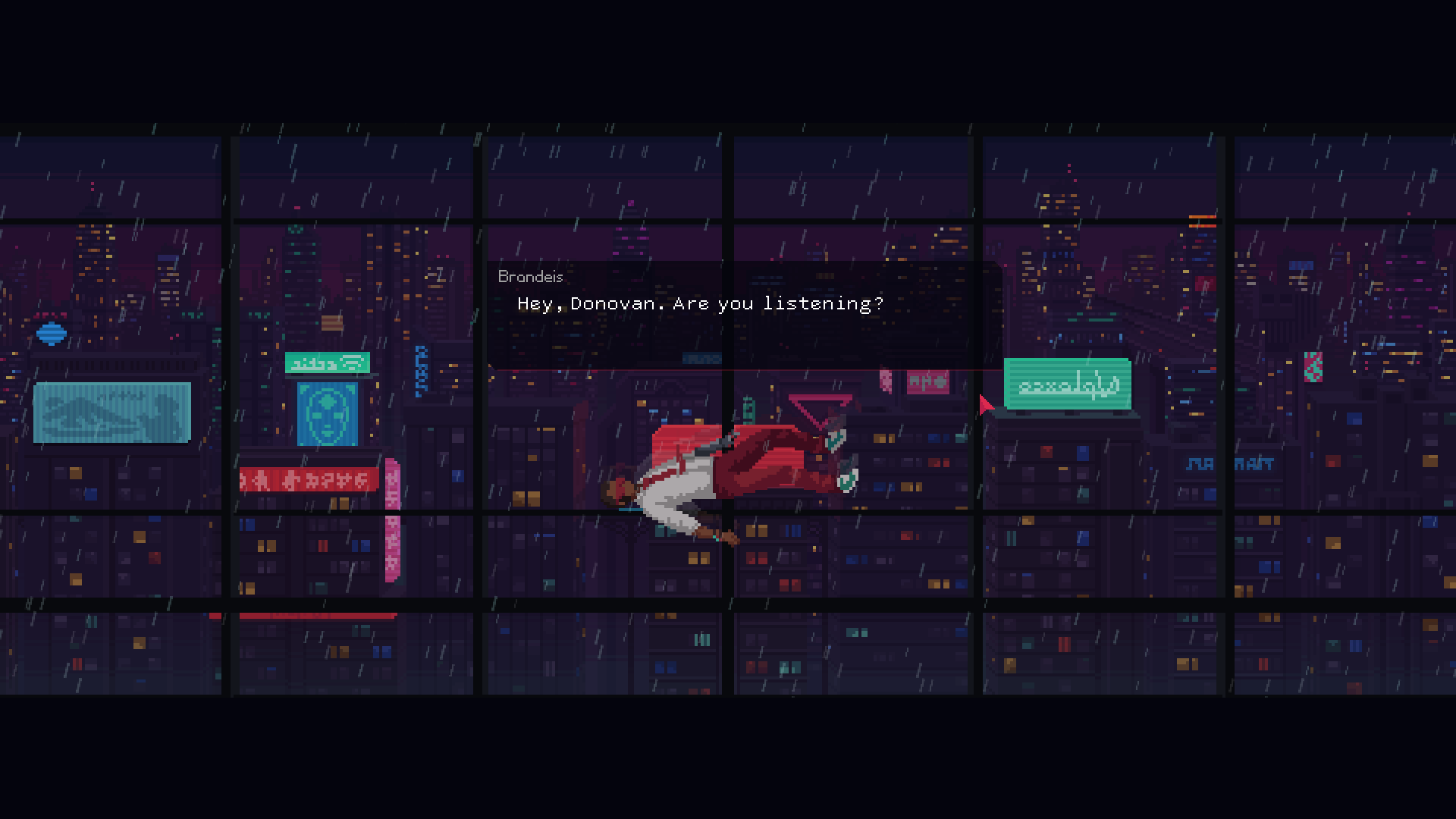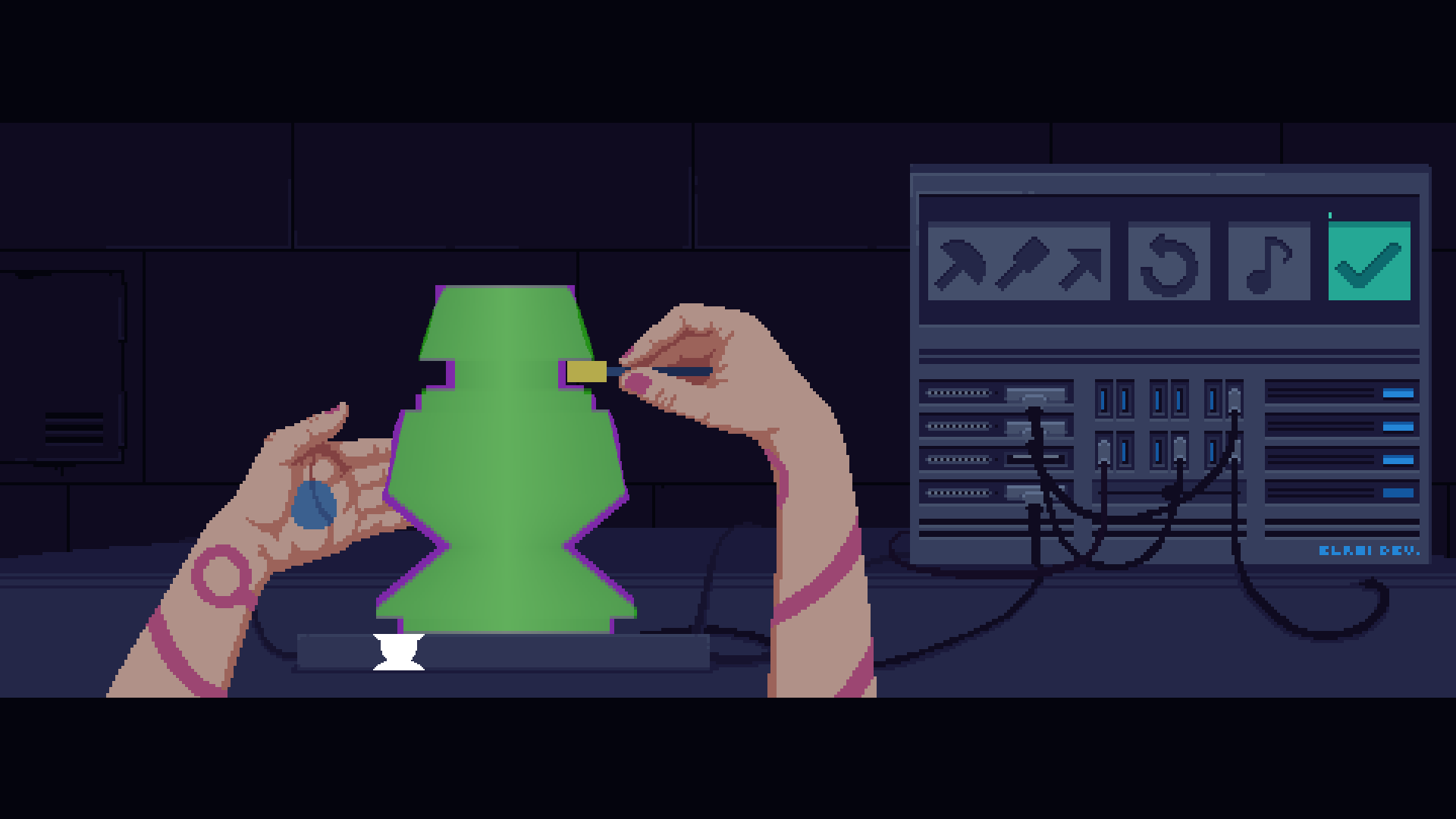
Leonardo Faierman is the senior film editor at Black Girl…
A classic and recognizable noir intro: meet our hero, falling from a great height, presumably to their death. A series of choices swirling in their head, in cantering step with the piano on the soundtrack, awash in mistakes and traveling scales, with potentially just enough time to reflect as the ground rushes up below. All of this submerged in a damp, chilly, but weirdly cozy recording of rainfall.
Was this worth it? Will their machinations survive them? Have the bad guys earned their comeuppance, even if our plummeting protagonist won’t be alive to see it? Is there yet an unseen hand that might save them?
Cyberpunk adventure The Red Strings Club is one of the best storytelling games I’ve played in years.

It’s got the branching paths of those games, and even tracks them for you in a widget in the top-left corner of the screen, the decisions percolated by several controllable characters. It’s less a game where you play a specific character, though; more so, you inhabit one of three at different times and considerably sudden intervals, each one centered on dialogue and an extended minigame. Three days to counter a grand societal revolution with one of your own, a population-hack, though the heroes involved seek not profit nor fame; to use its playful terminology, The Red Strings Club is a game about “revolutionary scoundrels.”
I like how it bucks some established noir trends, especially when it comes to the characters and characterizations. For a noir game—with its ashtray-topped piano, bartender banter, cocktail dresses, and grandiose character speeches—its narrative is unmistakably modern. In other words, it’s definitely not beholden to Chandler and Bogart, but happy to serve them a drink, when it gets to them.

Donovan runs the downtown bar The Red Strings Club, but he’s not your typical bartender. Communing with his muse—an unseen, incorporeal entity he calls “Numen”—he is able to mix specific drinks for his patrons that “tune into the customer’s emotions,” unveiling behaviors or moods which he can then exploit through conversation. As an information broker, this method unearths his most valuable currency, and will be crucial to fomenting the results that you as the player pursue.

Brandeis is Donovan’s polyamorous, bi-boyfriend, a revolutionary-adjacent freelance hacker, social engineer, and pianist. The normal flow of their night is interrupted when a damaged android shows up at the door, and the reason for this arrival will set the heroes off on their world-breaking journey, albeit one mostly conducted from the bartop.

Although The Red Strings Club takes place in some nondescript neon-soaked cyberpunk future, it grounds itself in modern corporate terminologies: Bitcoin, Google, Wikipedia, Twitter, YouTube. This pairs effectively with new names like “Supercontinent Ltd,” the megacorp which manufactures human implant body modifications, and persisting as the closest thing to an antagonist the early game can muster. But, as with all of these types of stories, there’s more than meets the (cybernetic) eye.
Minigames include the aforementioned drink-mixing, a fidgety but strangely satisfying affair where you pour drinks to pursue a patron’s “soul nodes” using your mouse. There’s also a pottery-style game, and a very involved bit of business where you’ll need to change the world with nothing but a voice implant and a phone.

That’s pretty much all there is to it, though the conversations and dialogue choices are arguably the main attraction. You’ll do everything from counter intrusive questions from a company-line-toeing lawyer to thinking up responses to “Should xenophobia and homophobia exist?”—two playthroughs and I still can’t quite say “yes” to that one, although I’m curious how it shifts the story.
Speaking of that: I will admit that I didn’t see an extremely detailed series of changes between those playthroughs, even when I really tried. The way one specific conversation resolves with a particular character was something I wanted to buck hard on a second playthrough, to see if it would significantly alter the end-game, but my hand ended up forced; the game actually made me serve this character a different drink, otherwise he wouldn’t respond to a question and allow the conversation to continue. The red strings may get tangled, sure, but the edges of the container feel decidedly there all the same. That being said: a few key scenarios did play out quite differently, of course, but I just wouldn’t expect a complete butterfly-winged difference resultant from your choices in every case is all.
The game also really tries to present an effectively responsible approach to diversity throughout. For the “Akara” android that shows up at the door, Brandeis uses the prefix “miss,” at first; later on, and unarticulated in any apparent dialogue, the two refer to them using nonbinary descriptors like “them” and “they.” This is unprompted, it feels merely polite, but the sensitivity and subtlety stood out to me.

More important to the story than a character’s sexual orientation or gender identity, however, is their employment. Each of the patrons at The Red Strings Club has an array of professional responsibilities, pursuits, corporate dues it wants to protect or increase. It feels like the game partially wants to communicate something about work, about how work shapes us and clouds our judgment, sows the seeds of doubt, terrifies us, gives us our strength.
I played through The Red Strings Club twice, but note that this is a modest use of time, at about three hours needed per playthrough. During that time you’ll chat with almost a dozen or so “neons,” all of whom affect the schemes of a world-bearing overarching plot, all from the relative safety of a bar or a phone. But is it a normal bar? Is there something else going on aside from technological sabatoge?
I don’t think any aforementioned wrinkles are any reason to avoid the game, mind you, and experiencing it on a minute-to-minute basis is an unqualified pleasure. The sumptuous soundtrack (a digital release is forthcoming on 1/26) is as absorbing as the detailed, characterful art, and every single patron has their own beautifully realized audio compositions. Part of this review is being written with the game alt-tabbed, right now, and I can hear Larissa Robillard’s plaintively sexual yet melancholic electro club jam beating in the background, one of my favorites. From those first tickled keys upon starting the game up to its final moments back around, you’ll probably decide that you need a copy of this soundtrack. I definitely do.
The main criticisms I’d levy are that the general animations are less impressive than the static art and overall sensibilities of the game’s visual design, which makes some character movements or actions slightly jarring. And the story, of which I personally enjoyed pretty much every twist and development, might be seen as somewhat reductive or even strained by some. It’s morally foggy, and in the course of its philosophical meanderings might come off as a little too clever, not unlike those Akara androids themselves. Regardless, I enjoyed sparring with those morals, even when some prompted responses felt a little synthetic or overly manicured—it’s the coin of the realm for this genre, and more than enough of it really, really worked for me.

The Red Strings Club is brash. It’s big-hearted. It’s gigglingly foulmouthed and risque, yet never quite immature. It’s an atmospheric, gorgeously instrumented series of vignettes, a true point-and-click adventure that feels like it was designed from the start to be mechanically satisfying to play. It’s as sad and frustrating and sweet and hilarious as some of its character’s lives, with memorable scenes that’ll make you smile when they manifest again on each subsequent playthrough.
It’s as Donovan says: We’re all screwed. We’re all safe.
The Red Strings Club releases today, January 22nd, on Steam. Review copy provided by publisher and completed on PC.
Leonardo Faierman is the senior film editor at Black Girl Nerds. Born in Buenos Aires, raised in Queens, Bar Mitzvah'd at Young Israel, buried under student loans. He writes video game, music, film, and movie reviews, as well as poetry, comic books, bad dreams and good copy. He's 1/5th of the comics podcast #BlackComicsChat and 1/2 of horror film podcast The Scream Squad.









